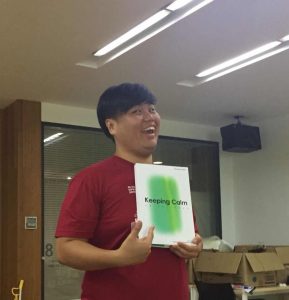Design Thinking and Expression
My initial impression: I had expected this course to possibly be something related to the aesthetics aspect of design or some kind of art form. But this course was more than that. Each group needed to design a book of something according to their design expression. First, we had to think of a design statement – that will form the meaning behind what we want to design or express. Then think of how to express it. The course instructor encourages us to think of how to express it in a more abstract manner, which is part of the design process. Next, using their paper actuator technology, we design mechanisms that aids in the execution of our expressions. 3d printed material (using ABS or PLA filament) on paper can be controlled electronically or thermally which in turn controls the movement of the paper. But of course, all these were more easily said than done, since they require fine control of the flexibility of the printed 3d material and understanding the interaction between forces – weight of the paper and the bending power of the 3d printed material. Often, these require multiple rounds of testing to be able to understand how it works.
For my group, we chose to do a book of ‘keeping calm’ as we were inspired by my theme’s project, where one of the functions of our table lamp is to help people relax according to a 4-7-8 breathing pattern. Under the guidance and advice of the course instructor and the TAs, we designed our book using multiple circular pods with moveable opening flaps, and they are all arranged in a double spiral format to give it a ‘rotation’ feel. Personally for us, that weekend was hectic because not only did we need to complete this assignment, but also because each of us had already made plans for that weekend – families visiting us and/or travelling out of Hangzhou. But because I was the only one left in Hangzhou, I had to be the one to do it. While I went out in the day with my aunt, I spent my nights (as well as early mornings) doing the assignment. Although more could be done to produce the effect we wanted, I think we were all satisfied with what we had given the time we have.

Caoban Visit
As a foodie, as someone who loves cooking, and as a grub club exco, how could I not sign up for a factory visit of the production of stove tops and the latest technologies used? Needless to say, stoves are very essential in cooking, as they provide the source of heat. But what I’m impressed about caoban is that their design is a 2-in-1 concept that takes into account not just the design of the stove top but also the fume hood, which has a good record of being able to take in 99.8% of all the fumes and smoke produced during cooking. Furthermore, they prioritised safety in their design, where if the flames reached above a certain height or temperature, it automatically shuts off the stove. They take many safety considerations in their design, and it reassures me if I were to buy their product as a customer. Additionally, what I appreciate a lot about cao ban is also their forward-thinking mindset, as seen when they worked with students of Zhejiang University to design their latest smart stove, which includes different sensors to detect flames and temperature when they rise as mentioned above. As an aspiring EPD student who is also working on a smart product, I can’t help but think of how the data collected could be used to further fine tune and optimise the product for usage based on each user because every home environment is slightly different. Machine learning is such a huge thing now and I think it would be cool if the product grows with the user as well.































